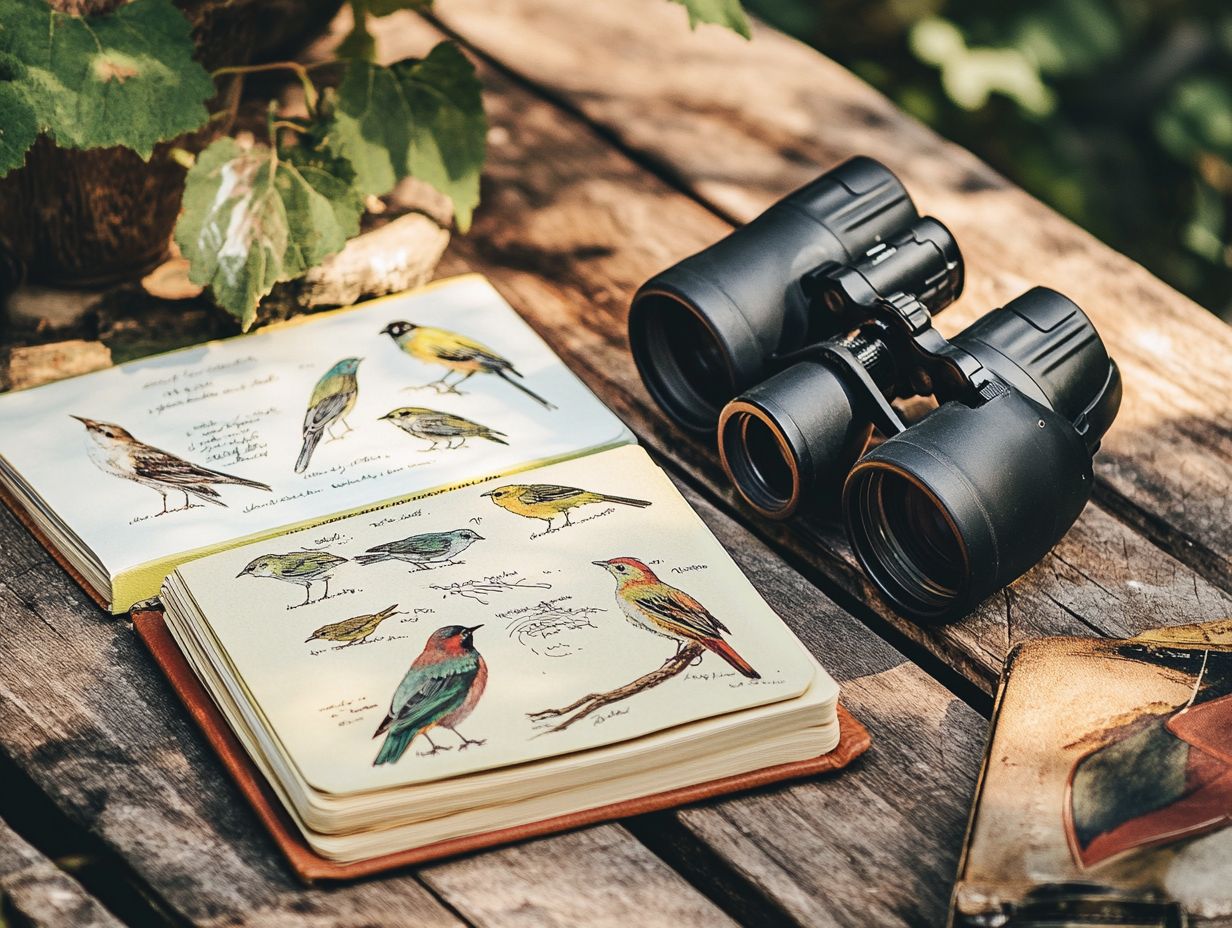Field Guides: Essential for Every Birdwatcher
Birdwatching is a captivating hobby that connects you with nature and its exquisite feathered inhabitants.
A field guide is your key to unlocking the beauty of birdwatching. It is an invaluable tool that helps you identify various species, understand their behaviors, and appreciate their unique habitats.
This article delves into what makes a field guide indispensable. It covers how to select the perfect one for your needs, its essential features, and offers tips for crafting your own personalized guide.
We will also explore the rise of digital resources in this field. Whether you’re a beginner or an experienced observer, now is the perfect time to elevate your birdwatching adventures!
Contents
Key Takeaways:

- Field guides are essential for every birdwatcher, providing valuable information and aiding in identification.
- When choosing a field guide, consider factors such as location, level of detail, and ease of use.
- A good field guide should have clear visuals and concise descriptions, as well as a well-organized and user-friendly layout.
The Importance of Field Guides for Birdwatchers
Field guides are critical tools for birdwatchers in North America.
They offer vital insights into the diverse species that inhabit the United States.
Whether you prefer the tactile feel of a printed guide or the convenience of a digital format, these resources empower you to identify birds with precision through detailed pictures, descriptions, and expert identification techniques.
Renowned options like the Sibley Guide, Kaufman Guide, and Audubon Bird Guide not only enhance your birdwatching experience but also play a significant role in conservation by deepening your understanding of the variety of birds. For more insights, check out how field guides enhance your bird watching.
With the latest advancements in mobile apps and digital guides, bird identification is more accessible than ever. You can connect with the avian world whenever and wherever you choose.
What are Field Guides?
Field guides are your go-to resources, whether in book form or digital format.
They delve into the fascinating world of bird species, offering insights into their habitats, behaviors, and unique characteristics.
This makes it easier for you to identify them while out in the field.
These guides come in various formats, tailored to suit your level of expertise and specific interests.
Some may provide extensive descriptions and intricate pictures designed for seasoned professionals, while others are perfect for beginners, featuring simplified visuals and essential identification tips.
Accurate illustrations are vital, as clear images help you distinguish between similar species, where even the smallest detail can make all the difference.
While printed guides offer the satisfying tactile experience many nature enthusiasts treasure, digital options bring their own advantages.
With interactive features and seamless updates, you can easily keep up with the latest discoveries in bird research.
Choosing the Right Field Guide
Selecting the right field guide is crucial for your bird identification journey.
Given the vast array of bird species throughout North America, having tools specifically designed for your unique environments and interests makes all the difference.
Factors to Consider
When selecting a field guide, several factors come into play.
Consider your geographic region of interest, the types of birds you re observing, and whether you prefer a printed edition or a digital format.
User-friendliness can significantly enhance your experience, with a clear layout and intuitive navigation allowing for quick identification in the field.
Portability is another crucial factor; a lightweight and compact guide makes it much easier to carry during long hikes or trips.
The inclusion of detailed illustrations is vital, as vivid images can help with memorization and recognition.
And let s not forget about binoculars; having a reliable pair is essential. They provide the necessary magnification to observe fine details, enriching your overall birdwatching experience.
Features of a Good Field Guide

A quality field guide must include several essential features that enhance its ease of use for birdwatchers. Look for navigating the world of birds with clear and vivid illustrations, well-organized content, and thorough descriptions of each bird species.
These elements will significantly improve your birdwatching experience.
Visuals and Descriptions
Visuals and descriptions are vital components of field guides. They provide the context you need for accurate bird identification through detailed illustrations and informative text.
The evolution of illustration styles has notably influenced how you and other enthusiasts perceive birds. Modern guides present not only lifelike portrayals but also artistic interpretations that capture the very essence of each species.
This artistic progression makes it easier for you to appreciate the subtle differences in plumage and shape.
Alongside these visuals, descriptive text enhances your experience, offering insights into the behaviors and habitats of birds. This fosters a deeper understanding and appreciation of avian life.
By combining visuals with informative descriptions, these guides become invaluable resources for both novice birders and seasoned ornithologists, highlighting the importance of field guides in bird watching.
Organization and Layout
The organization and layout of a field guide are crucial for its ease of use. They directly affect how easily you can navigate through various bird species and locate the information you need.
An intuitive layout doesn t just make the experience enjoyable; it actively enhances your learning. This allows you to quickly reference key information without the usual frustration.
With features like tabs, distinct categories, and color-coded sections, the discovery process becomes streamlined. This enables you to efficiently sift through the multitude of options available.
Some guides take a systematic approach, categorizing birds by habitat or behavior. Others may adopt a more linear structure based on color or size. Whether in printed or digital formats, these organizational strategies should cater to all expertise levels, ensuring that both novice birdwatchers and experienced ornithologists can find value and insights with ease.
How to Use a Field Guide Effectively
To effectively use a field guide, understand how to optimize its features for successful bird identification during your birdwatching adventures.
Embrace the guide’s nuances, allowing it to enhance your experience as you observe and connect with the avian world around you.
Tips and Techniques
Utilizing specific tips and techniques can significantly enhance your bird identification skills when using a field guide. This transforms your experience into something truly rewarding and enjoyable.
By honing your observational skills, you’ll become more attuned to the subtle behaviors and characteristics that set different species apart.
Mastering the art of using binoculars (a tool for magnifying distant objects) effectively will grant you closer, clearer views. This lets you spot markings and color variations that might otherwise escape your notice.
Learning to interpret the illustrations and descriptions in your guide is crucial. Understanding how artists capture field marks in various contexts can lead to more accurate identifications.
By combining these strategies, you deepen your connection to nature and elevate your satisfaction as you identify and appreciate the avian world surrounding you.
Creating Your Own Field Guide

Creating your own field guide is a thrilling adventure that every birdwatcher should experience! It offers the opportunity to curate personalized content that highlights how field guides can improve your birdwatching skills by showcasing the specific bird species and local habitats you encounter during your birding adventures.
Start your birdwatching journey today with a great field guide!
Personalized and Customized Guides
Personalized guides empower you to focus on specific bird species. This enhances your identification skills and deepens your connection with the avian community.
Capture your unique observations today! By documenting your experiences in these tailored guides, you create a valuable resource that reflects your individual journey.
This approach promotes mindfulness during your birdwatching excursions. It also aids in the retention of knowledge over time.
Incorporating your favorite species adds a personal touch. This enables you to prioritize the birds that resonate with you most.
Customizing information based on specific locations enhances the relevance of the data. Bird populations and conditions can vary across different environments.
Ultimately, these field guides serve as both an educational tool and a cherished keepsake, enriching your overall birdwatching experience.
Field Guide Apps and Online Resources
The emergence of field guide apps and online resources marks a significant transformation in birdwatching. You have immediate access to an extensive repository of information on bird identification and species throughout North America, including must-have field guides for eastern U.S. birds like the Sibley Guide and Kaufman Guide.
Pros and Cons
While field guide apps and online resources offer numerous advantages, be aware of their limitations to make the most of your birdwatching adventure!
Having an entire digital library at your fingertips elevates your birdwatching experience. You gain quick access to up-to-date information and interactive features like audio calls, along with insights from photo guides and resources like the Audubon Bird Guide.
This reliance on technology presents challenges. You may face battery life issues and the need for constant internet connectivity, which isn t always available in remote locations, especially in Texas and Oklahoma.
Balancing the use of digital guides like the Merlin Bird ID app with traditional printed materials, such as the Peterson Field Guide, allows for a more comprehensive approach.
This strategy lets you enjoy the best of both worlds while ensuring you’re prepared for any situation in the field, whether observing raptors or storm-petrels.
Frequently Asked Questions
What is a field guide?

A field guide is a book or resource, such as the Crossley ID Guide or Golden Guide, that provides detailed information and illustrations of different species of birds. It helps birdwatchers identify and learn about the birds they observe.
Why are field guides essential for birdwatchers?
Field guides like the National Geographic Field Guide are essential because they provide accurate and reliable information about the birds you observe. Resources such as field guides: your birdwatching companion help differentiate between similar species, such as those in the Fringillidae or Cardinalidae families, enhancing your birdwatching experience.
What types of information are included in a field guide?
A field guide usually includes information on bird anatomy, behavior, habitat, range, and other distinguishing characteristics. This may include plumage, calls, and size, as well as specific details for regions like California or Texas. Maps and illustrations aid in identification.
Are field guides only for experienced birdwatchers?
No, field guides like the Kaufman Field Guide are for all levels of birdwatchers, from beginners to experts. They are a useful tool for anyone interested in learning more about birds and their species, including the most useful field guides for travel birding found throughout the United States.
Can I use a digital field guide instead of a physical book?
Yes, digital field guides like the Panasonic FZ80 and Celestron Outland are increasingly popular. They can be just as informative and helpful as traditional physical books, with the added benefit of being more portable and easier to search for specific species.
Start your birdwatching journey today! Share your observations with us!
Are field guides specific to certain regions or countries?
Yes, some field guides focus on specific regions, like Texas and California. These areas have different types of birds, making it essential to use a guide that matches your birdwatching location.
Using a regional bird field guide ensures you get the most accurate information. It enhances your birdwatching experience and helps you spot more birds!






